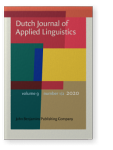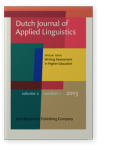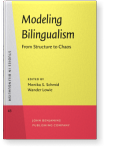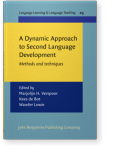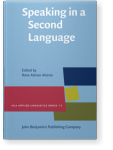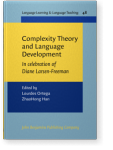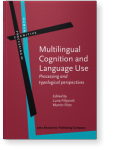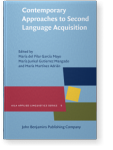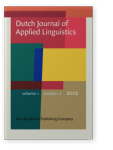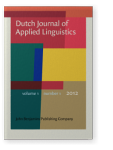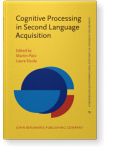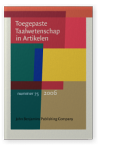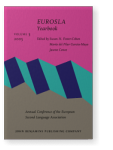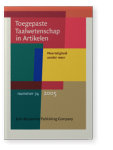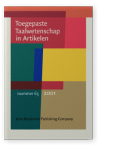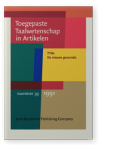Wander Lowie
List of John Benjamins publications for which Wander Lowie plays a role.
Journal
Titles
Writing Assessment in Higher Education
Edited by Bert Weltens, Jos Hornikx, Wander Lowie, Petra Poelmans and Rebecca L. Present-Thomas
Special issue of Dutch Journal of Applied Linguistics 2:1 (2013) ix, 132 pp.
Subjects Applied linguistics | Language acquisition | Language teaching | Multilingualism
Modeling Bilingualism: From Structure to Chaos. In Honor of Kees de Bot
Edited by Monika S. Schmid and Wander Lowie
[Studies in Bilingualism, 43] 2011. vii, 308 pp.
Subjects Multilingualism | Theoretical linguistics
A Dynamic Approach to Second Language Development: Methods and techniques
Edited by Marjolijn H. Verspoor, Kees de Bot and Wander Lowie
[Language Learning & Language Teaching, 29] 2011. ix, 211 pp.
Subjects Applied linguistics | Language acquisition | Language teaching
2020 An English academic reading course for Dutch pre-university students Dutch Journal of Applied Linguistics 9:1/2, pp. 207–214 | Article
In this research note we argue that reading lessons for the subject of English in Dutch pre-university education require adjustments. Currently, these lessons do not prepare students well for university reading. Too often, lessons emphasize searching for information, the dominant skill to pass… read more
2020 Methodological concerns and their solutions in third-age language learning studies Dutch Journal of Applied Linguistics 9:1/2, pp. 97–108 | Article
With the average life expectancy in especially developed countries steadily increasing, healthy ageing is prioritised on the research agenda. Various studies have looked into bilingualism as a possible anti-ageing tool to delay the onset of symptoms of degenerative diseases like Alzheimer’s,… read more
2018 Chapter 5. The acquisition of L2 speaking: A dynamic perspective Speaking in a Second Language, Alonso, Rosa Alonso (ed.), pp. 105–125 | Chapter
The complex dynamic systems theory approach to second language development has great explanatory power in accounting for the development of speaking as an emergent process. CDST approaches focus on the process of development, rather than on the products of learning, and often include the… read more
2017 Chapter 6. Lost in state space? Methodological considerations in Complex Dynamic Theory approaches to second language development research Complexity Theory and Language Development: In celebration of Diane Larsen-Freeman, Ortega, Lourdes and ZhaoHong Han (eds.), pp. 123–142 | Chapter
Since we can only make the observations our method allows us, we will have to adjust our method of investigation to the phenomena and questions we are interested in within the context and timescale of our focus. If we want to test hypotheses about the grand sweep effects of factors affecting… read more
2014 Aging and bilingual processing: Age-related and individual differences in groups of early bilingual Frisians Multilingual Cognition and Language Use: Processing and typological perspectives, Filipović, Luna and Martin Pütz (eds.), pp. 263–286 | Article
We conducted a study to investigate effects of bilingualism on nonverbal and verbal cognitive performance. Here we report on the results from the first part of our study, in which 26 middle-aged (MA 46) and 26 elderly (MA 73.2) early bilingual speakers of Dutch and Frisian performed a verbal… read more
2013 Chapter 10. Dynamic Systems Theory as a comprehensive theory of second language development Contemporary Approaches to Second Language Acquisition, García Mayo, María del Pilar, María Juncal Gutiérrez Mangado and María Martínez-Adrián (eds.), pp. 199–220 | Chapter
In this contribution it is argued that Dynamic Systems Theory (DST) can be seen as a comprehensive theory that can unify and make relevant a number of different ‘middle level’ theories on Second Language Acquisition (SLA) which in our view are theories that attend to different levels of granularity… read more
2013 EMBEDding the CEFR in academic writing assessment: A case study in training and standardization Writing Assessment in Higher Education, Weltens, Bert, Jos Hornikx, Wander Lowie, Petra Poelmans and Rebecca L. Present-Thomas (eds.), pp. 77–91 | Article
The CEFR is increasingly being used as the framework of choice for the assessment of language proficiency at universities across Europe. However, to attain consistent assessment, familiarization and standardization are essential. In this paper we report a case study of embedding a standardization… read more
2012 A dynamic perspective on language processing and development Dutch Journal of Applied Linguistics 1:2, pp. 188–218 | Article
If language processing and development is viewed as a dynamic process in which all subsystems interact over time, then some basic assumptions behind more traditional approaches to language analysis are problematic: new methods of analysis and modeling are needed to supplement and partly replace… read more
2012 Conventionalized ways of saying things (CWOSTs) and L2 development Dutch Journal of Applied Linguistics 1:1, pp. 125–142 | Article
Taking a usage-based approach, this paper aims to define conventionalized ways of saying things (CWOSTs) as multi-word units so that they can be included in researching L2 development. We build on Langacker’s (2008) “normal ways of saying things”, here understood as conventionalized… read more
2011 Introduction A Dynamic Approach to Second Language Development: Methods and techniques, Verspoor, Marjolijn H., Kees de Bot and Wander Lowie (eds.), pp. 1–4 | Introduction
2011 Variability and DST A Dynamic Approach to Second Language Development: Methods and techniques, Verspoor, Marjolijn H., Kees de Bot and Wander Lowie (eds.), pp. 55–84 | Article
2011 Introduction: From structure to chaos: Twenty years of modeling bilingualism Modeling Bilingualism: From Structure to Chaos, Schmid, Monika S. and Wander Lowie (eds.), pp. 1–12 | Article
2011 The dynamics of multilingualism: Levelt’s speaking model revisited Modeling Bilingualism: From Structure to Chaos, Schmid, Monika S. and Wander Lowie (eds.), pp. 267–288 | Article
Levelt’s blueprint of speech production and perception (Levelt 1989; Levelt, Roelofs, & Meyer 1999) has been widely accepted and is well established. One of the crucial characteristics of the model is its modularity, which is required to account for the speed with which we speak (about two to three… read more
2011 Modeling development and change A Dynamic Approach to Second Language Development: Methods and techniques, Verspoor, Marjolijn H., Kees de Bot and Wander Lowie (eds.), pp. 99–122 | Article
2011 How to sections A Dynamic Approach to Second Language Development: Methods and techniques, Verspoor, Marjolijn H., Kees de Bot and Wander Lowie (eds.), pp. 129–200 | Article
2010 7. On the stability of representations in the multilingual lexicon Cognitive Processing in Second Language Acquisition: Inside the learner's mind, Pütz, Martin and Laura Sicola (eds.), pp. 117–134 | Article
2010 8. Conceptual representations in the multilingual mind: A study of advanced Dutch students of English Cognitive Processing in Second Language Acquisition: Inside the learner's mind, Pütz, Martin and Laura Sicola (eds.), pp. 135–148 | Article
2006 Voorwoord Toegepaste Taalwetenschap in Artikelen 75, pp. 7–8 | Article
2005 Exploring a second language: The discovery of morphological productivity EUROSLA Yearbook: Volume 5 (2005), Foster-Cohen, Susan H., María del Pilar García Mayo and Jasone Cenoz (eds.), pp. 251–268 | Article
A dynamic approach to the acquisition of morphologically complex words assumes that, initially, all words are interpreted holistically. At later stages of acquisition, increasingly more words are analyzed and morphological regularities are discovered. When productivity is defined as the chance that… read more
2005 Voorwoord Meertaligheid zonder meer, pp. 7–9 | Article
2001 Het Leren van Polyseme Woorden Vanuit de Kernbetekenis Toegepaste Taalwetenschap in Artikelen 65, pp. 9–21 | Article
Studies in vocabulary acquisition have shown that guessing words from context may have a positive effect on eventual retention, but is not necessarily the most effective or efficient method in instructional settings. However, when cognitive linguistic insights into the conceptual links between… read more
1991 Derivationele Morfologie In Tweede-Taalverwerving TTW: De nieuwe generatie, pp. 83–92 | Article
This article deals with the influence of a learner's native language in the acquisition of L2 derivational morphology. Do learners acquire morphologically complex words like 'learnable' and 'explanation' as unanalysed units or do they acquire and store the stems ('learn'; 'explain') and… read more
